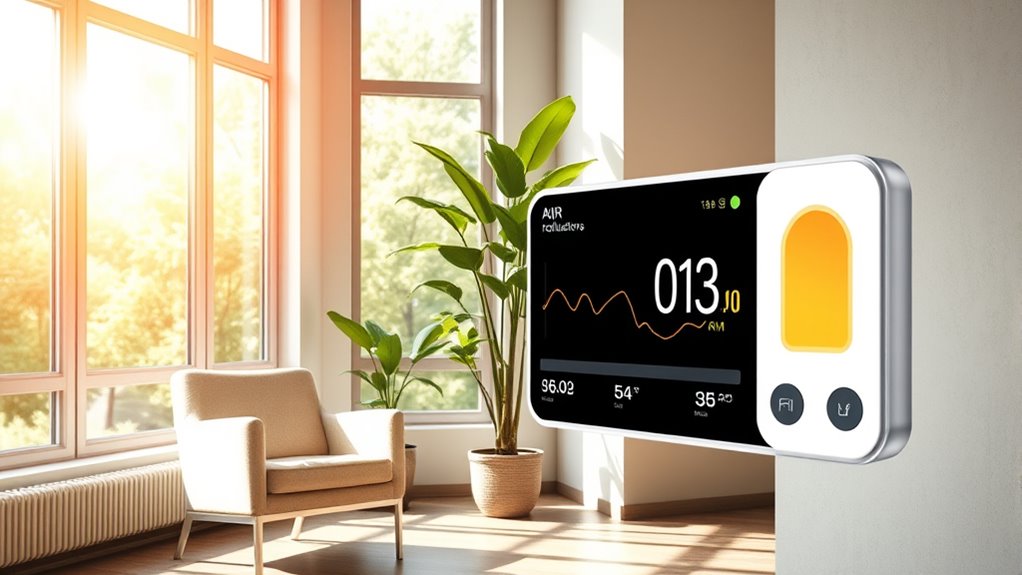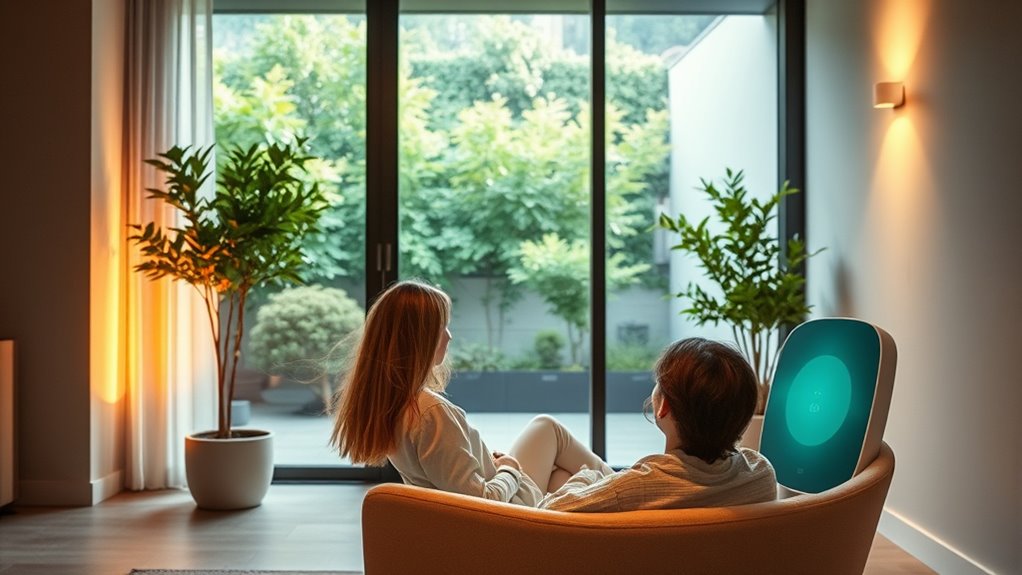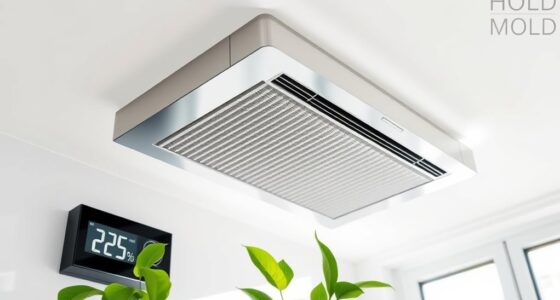Balancing thermal comfort and air quality means maintaining the right humidity, temperature, and clean air to feel comfortable and stay healthy. Too warm or humid, and you risk mold and dust mites; too cold or dry, and your skin and respiratory system suffer. Proper use of humidifiers, dehumidifiers, filters, and ventilation helps find that perfect middle ground. If you want to understand how to achieve this balance effectively, there’s more to discover below.
Key Takeaways
- Maintaining indoor humidity levels between 40-60% optimizes both thermal comfort and air quality.
- Proper filtration reduces airborne pollutants, supporting healthier air without compromising comfort.
- Overly dry or humid environments can disrupt comfort and promote mold or dust issues, affecting air quality.
- Ventilation systems help balance fresh air intake with humidity control, enhancing overall indoor environment.
- Regular monitoring and adjusting humidity, filtration, and airflow ensure a sustainable balance for comfort and health.

Balancing thermal comfort and air quality is a common challenge in maintaining a healthy indoor environment. When you focus on keeping your space comfortable, you might overlook the importance of air quality, but both are essential for your well-being. One key factor in achieving this balance is humidity control. Too much humidity can make your environment feel damp and stuffy, encouraging mold growth and dust mites, which can worsen allergies or respiratory issues. Conversely, low humidity can cause dryness, leading to irritated skin, sore throats, and increased susceptibility to colds. You need to find that sweet spot where humidity levels stay between 40% and 60%, guaranteeing comfort without sacrificing air quality. Using humidifiers or dehumidifiers helps you regulate this balance effectively, especially in climates with extreme weather changes.
Maintaining 40–60% humidity balances comfort and air quality effectively.
Along with humidity control, air filtration plays an indispensable role in maintaining good indoor air quality. Poor filtration can allow dust, pollen, pet dander, and other airborne pollutants to circulate freely, impacting your health and comfort. Upgrading your air filtration system with high-efficiency filters, such as HEPA filters, can dramatically reduce these contaminants. Regularly changing filters guarantees they perform at their best, preventing the buildup of particles that can compromise your indoor air. When you combine proper humidity management with efficient air filtration, you create an environment that’s both comfortable and healthy. Additionally, integrating robotic air purifiers**** can further enhance air cleaning efficiency and reduce maintenance efforts.
It’s important to think about how these two factors interact. For instance, high humidity levels can reduce the effectiveness of certain air filtration systems by promoting mold growth within the filters or ducts. On the other hand, overly dry air can lead to increased dust circulation, making filtration less effective and causing irritation. Monitoring humidity levels with a hygrometer allows you to adjust your humidifiers or dehumidifiers accordingly, guaranteeing your air filtration system functions as intended.
You should also pay attention to ventilation. Good ventilation helps remove indoor pollutants and introduces fresh air, complementing your humidity control and filtration efforts. Properly ventilated spaces prevent stale air from accumulating and help maintain ideal humidity levels. Incorporate air purifiers with activated carbon filters to tackle odors and chemical pollutants, further enhancing air quality.
In your pursuit of the perfect indoor environment, remember that maintaining a balance between thermal comfort and air quality requires ongoing attention. By actively managing humidity and investing in quality air filtration, you can create a space that feels just right—comfortable enough to relax and healthy enough to support your well-being.
Frequently Asked Questions
How Does Humidity Affect Thermal Comfort and Air Quality?
Humidity substantially impacts both thermal comfort and air quality. When humidity levels are high, it becomes harder to regulate temperature, making you feel warmer and uncomfortable. Proper humidity regulation and moisture control help maintain a balanced environment, preventing mold growth and dust mites that degrade air quality. Conversely, low humidity can cause dryness and irritation. By managing humidity effectively, you create a space that feels comfortable and promotes healthier indoor air.
Can Air Purifiers Improve Both Air Quality and Thermal Comfort?
An air purifier can markedly boost both air quality and thermal comfort. While their primary role is improving air purifier efficiency by filtering pollutants, some models also help with thermal regulation by reducing humidity or circulating air. You might feel like you’ve just stepped into paradise, enjoying fresher air and a more comfortable temperature. Just make certain you choose a device designed for your space to get the best balance of air quality and thermal comfort.
What Are the Latest Technologies for Balancing Comfort and Air Purity?
You can balance comfort and air purity using smart ventilation systems that automatically adjust airflow based on room conditions. Advanced filtration technologies, like HEPA and activated carbon filters, remove pollutants without compromising temperature. These innovations work together to optimize indoor environments, ensuring you stay comfortable while maintaining high air quality. By integrating smart controls with powerful filtration, you create a healthier, more comfortable space effortlessly.
How Do Outdoor Environmental Factors Influence Indoor Air Quality and Temperature?
Ever wonder how outdoor pollutants and sunlight exposure secretly influence your indoor environment? These factors can dramatically alter indoor air quality by introducing pollutants or increasing temperature through sunlight. As outdoor air becomes more polluted, it can seep inside, reducing air quality. Simultaneously, sunlight exposure warms your space, impacting thermal comfort. Staying aware of these influences helps you better control your indoor environment for ideal comfort and air purity.
Are There Specific Materials That Enhance Both Thermal Comfort and Air Quality?
You can enhance both thermal comfort and air quality through material innovation and surface treatments. Look for materials like natural fibers, which improve insulation and promote airflow, and surface treatments that reduce VOC emissions and inhibit mold growth. These options help maintain a comfortable indoor environment while ensuring good air quality. By choosing advanced materials and treatments, you create a healthier, more comfortable space that balances temperature regulation with air purity.
Conclusion
Just as Icarus learned that balancing ambition with caution is essential, you must find harmony between thermal comfort and air quality. Ignoring one for the other can lead to discomfort or health risks. Endeavor to create an environment where both coexist smoothly, much like the delicate balance of a tightrope walk. Remember, achieving this equilibrium requires awareness and effort—so you can enjoy a space that’s both cozy and safe, without reaching for the impossible heights.









